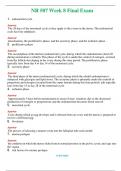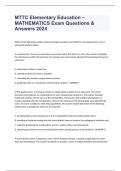GMS522 Midterm Exam | Questions And Answers Latest {2024- 2025} A+ Graded | 100%
Verified
international marketing - the process of planning and conducting transactions across national borders to
create exchanges that satisfy the objectives of individuals and organizations.
(international sales are seen as secondary to developing the domestic market)
multidomestic marketing strategy - the development of separate marketing strategies for each country
that a firm conducts business activities in (if you are in latin america there is one strategy for brazil, one
for argentina, etc.)
the market concept - the need to identify and satisfy unique customer needs in order to increase sales,
maximize profits and beat competition
global marketing - the marketing activities that are coordinated and integrated across multiple country
markets. integration involves product standardization (identical brand names, similar advertising
messages, consistent packaging, etc.)
why global marketing activities? - - expansion
- survival: if business is not conducted by the domestic firm on a global level, at some point they will be
beat by their foreign rivals
glocal marketing - attempting to balance standardization with local customer needs, "think global, act
local"
e.g. mcdonalds - in germany mcdonalds sells beer, whereas in the us they have different perceptions of
alcohol, mcdonalds - does not serve beef on the menu in india due to hindu community's belief system,
coca cola - markets "qoo" in japan
what is globalization? - a trend towards greater interdependence among national institutions and
economies. this is beneficial to consumers bc they are exposed to a wider array of products and ideal for
businesses due to visible expansion opportunities
,two forms of globalization - 1. globalization of markets - convergence of buyer preferences in markets
around the world
2. globalization of production - dispersal of production activities to locations around the world that are
low cost or high quality producers (usually shift production in an effort to reduce costs)
e.g. in 2010 vietnam replaced china as nike's largest production base worldwide
e.g. b/c trump has imposed tariffs on manufactured products in the US, harley davidson wants to
relocate their production to europe
the five key drivers of globalization - 1. market - differences in brands
2. cost - cost savings
3. environmental - reduction of tariff and non-tariff barriers, reduction of direct foreign investment
barriers
4. competitive - expansion to defend brand from competitors
5. technological - the internet - builds increased awareness of market conditions, etc.
axel dreher's three dimensions of globalization - 1. economic integration - examines trade and
investment flows between countries and the extent to which the country uses policy measures to
restrict these flows, constructed from variables such as fdi, imports and exports, portfolio investment,
average tariff rates and income payments to foreign nationals
2. social integration - reflects the flow and movement of ideas, people and info., captures data on
variables such as tourism flows between countries, telecom traffic, the number of international letters
sent, the number of Internet users, etc.
3. political integration - captures the diffusion of government policies around the world, incorporates
data on the number of embassies in a country, the number of international organizations to which the
country belongs and the number of UN peacekeeping missions the country participates in
dreher's globalization index - dreher's globalization index and sub-indexes range from 1 to 100 with
increasing values denoting greater globalization
liability of foreigness - the inherent disadvantages that multinational firms face when operating in a new
host country. this includes all additional costs multinational firms must bear in order to compete with
,local firms. foreign firms are put at a competitive disadvantage b/c they are not always aware of all
political, economic and social conditions of a country
economies of scale - refers to the decrease in per unit cost of production as the firm increases its level of
output (the more available, the less costly)
economies of scope - refers to the reduced cost per unit as the firm spreads its total costs (production,
marketing, R & D) over a large number of brands, product lines or target markets
ted levitt's homogeneous markets - ted levitt argued in 1983 that markets are becoming more
homogeneous and could be targeted with standardized products, people want the same things globally;
convergence of tastes and preferences, technology and communications were the drivers, ted's work
gave rise to the idea of "global marketing"
the anti-globalization movement - many people are angered by globalization due to the impact of the
trend on the poor (low wages), the environment, women and the ability of sovereign states to make
independent decisions. this anger led to protests such as the wto meeting in seattle on december 1999
that resulted in violent behaviour
culture - defined as an integrated system of learned behavior patterns that are distinguishing
characteristics of the members of any given society
cultural adaptation - everyone is encultured into a particular culture. however, problems may arise
when a person encultured in one culture has to adjust to a different culture, also known as becoming
"acculturated"
cultural universals - common traits that cut across all cultures such as mourning, body adornment,
decorative art, music, religious rituals and courtship (common across cultures, but practiced differently)
ethnocentricity - the belief that one's own ethnic group or culture is superior to that of others. this
causes people to view other culture in terms of their own, causing them to overlook import human and
environmental differences among cultures
consumer ethnocentricity - you think your culture is superior and therefore, feel that purchasing foreign
products is immoral
, e.g. " it is not right to purchase foreign products, because it puts americans out of jobs"
CETSCALE ethnocentricity - shimp and sharma (1987): measures the tendency towards being consumer
ethnocentric, useful in understanding negative consumer reactions towards foreign products
consists of 17 items which consumers rank on a scale of 1 (=strongly agree) to 7 (=strongly disagree)
polycentric - highly flexible in making decisions with respect to marketing, production and technology
choices in serving their local customers
regiocentric - firms with a regiocentric attitude view the world as a set of distinct regional markets, they
attempt to coordinate their business activities and strategies within these regions and not across them
geocentric - standardize products and adapt to the number of markets they serve
cultural literacy - detailed knowledge of a country that helps the manager to function effectively within
it such as understanding the pace at which business transactions can be completed
e.g. in mexico business transactions tend to proceed slowly in order to allow time for the parties to get
to know each other more on a personal level, whereas in north america such personal relationships are
not as important and transactions proceed at a much faster pace
the elements of culture - - language
- religion
- values and attitudes
- manners and customs
- material elements
- aesthetics
- education
- social institutions
in global marketing language is important in: - - collecting information
- providing access to the local society






